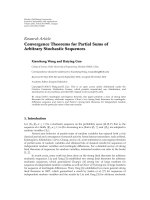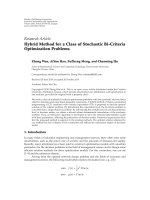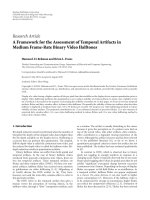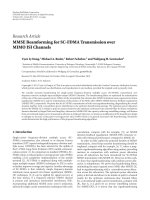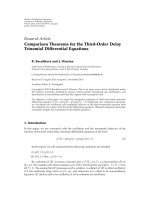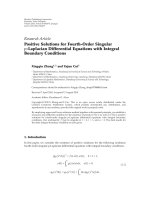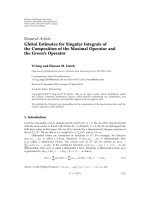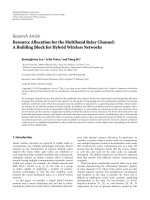Báo cáo hóa học: "Research Article Trace Inequalities for Matrix Products and Trace Bounds for the Solution of the Algebraic Riccati Equations" pot
Bạn đang xem bản rút gọn của tài liệu. Xem và tải ngay bản đầy đủ của tài liệu tại đây (521.77 KB, 17 trang )
Hindawi Publishing Corporation
Journal of Inequalities and Applications
Volume 2009, Article ID 101085, 17 pages
doi:10.1155/2009/101085
Research Article
Trace Inequalities for Matrix Products and
Trace Bounds for the Solution of the Algebraic
Riccati Equations
Jianzhou Liu,
1, 2
Juan Zhang,
2
and Yu Liu
1
1
Department of Mathematic Science and Information Technology, Hanshan Normal University,
Chaozhou, Guangdong 521041, China
2
Department of Mathematics and Computational Science, Xiangtan University, Xiangtan,
Hunan 411105, China
Correspondence should be addressed to Jianzhou Liu,
Received 25 February 2009; Revised 20 August 2009; Accepted 6 November 2009
Recommended by Jozef Banas
By using diagonalizable matrix decomposition and majorization inequalities, we propose new
trace bounds for the product of two real square matrices in which one is diagonalizable. These
bounds improve and extend the previous results. Furthermore, we give some trace bounds for
the solution of the algebraic Riccati equations, which improve some of the previous results under
certain conditions. Finally, numerical examples have illustrated that our results are effective and
superior.
Copyright q 2009 Jianzhou Liu et al. This is an open access article distributed under the Creative
Commons Attribution License, which permits unrestricted use, distribution, and reproduction in
any medium, provided the original work is properly cited.
1. Introduction
As we all know, the Riccati equations are of great importance in both theory and practice in
the analysis and design of controllers and filters for linear dynamical systems see 1–5. For
example, consider the following linear system see 5:
˙x
t
Ax
t
Bu
t
,x
0
x
0
, 1.1
with the cost
J
∞
0
x
T
Qx u
T
u
dt.
1.2
2 Journal of Inequalities and Applications
The optimal control rate u
∗
the optimal cost J
∗
of 1.1 and 1.2 are
u
∗
Px, P B
T
K,
J
∗
x
T
0
Kx
0
,
1.3
where x
0
∈ R
n
is the initial state of system 1.1 and 1.2 and K is the positive semidefinite
solution of the following algebraic Riccati equation ARE:
A
T
K KA − KRK −Q,
1.4
with R BB
T
and Q being positive definite and positive semidefinite matrices, respectively.
To guarantee the existence of the positive definite solution to 1.4, we will make the following
assumptions: the pair A, R is stabilizable, and the pair Q, A is observable.
In practice, it is hard to solve the ARE, and there is no general method unless the
system matrices are special and there are some methods and algorithms to solve 1.4;
however, the solution can be time-consuming and computationally difficult, particularly as
the dimensions of the system matrices increase. Thus, a number of works have been presented
by researchers to evaluate the bounds and trace bounds for the solution of the ARE see 6–
16. Moreover, in terms of 2, 6, we know that an interpretation of trK is that trK/n is the
average value of the optimal cost J
∗
as x
0
varies over the surface of a unit sphere. Therefore,
considering its applications, it is important to discuss trace bounds for the product of two
matrices. In symmetric case, a number of works have been proposed for the trace of matrix
products 2, 6–8, 17–20,and18 is the tightest among the parallel results.
In 1995, Lasserre showed 18 the following given any matrix A ∈ R
n×n
,B∈ S
n
, then
the following.
n
i1
λ
i
A
λ
n−i1
B
≤ tr
AB
≤
n
i1
λ
i
A
λ
i
B
,
1.5
where
A A A
T
/2.
This paper is organized as follows. In Section 2, we propose new trace bounds for
the product of two general matrices. The new trace bounds improve the previous results.
Then, we present some trace bounds for the solution of the algebraic Riccati equations, which
improve some of the previous results under certain conditions in Section 3.InSection 4,
we give numerical examples to demonstrate the effectiveness of our results. Finally, we get
conclusions in Section 5.
2. Trace Inequalities for Matrix Products
In the following, let R
n×n
denote the set of n × n real matrices and let S
n
denote the
subset of R
n×n
consisting of symmetric matrices. For A a
ij
∈ R
n×n
, we assume that
trA,A
−1
,A
T
, dAd
1
A, ,d
n
A,σAσ
1
A, ,σ
n
A denote the trace,
the inverse, the transpose, the diagonal elements, the singular values of A, respectively,
and define A
ii
a
ii
d
i
A.IfA ∈ R
n×n
is an arbitrary symmetric matrix, then
λAλ
1
A, ,λ
n
A and Re λARe λ
1
A, ,Re λ
n
A denote the eigenvalues
Journal of Inequalities and Applications 3
and the real part of eigenvalues of A. Suppose x x
1
,x
2
, ,x
n
is a real n-element array
such as dA,σA,λA, Re λA which is reordered, and its elements are arranged in
nonincreasing order; that is, x
1
≥ x
2
≥ ··· ≥ x
n
. The notation A>0 A ≥ 0 is used
to denote that A is a symmetric positive definite semidefinite matrix.
Let α, β be two real n-element arrays. If they satisfy
k
i1
α
i
≤
k
i1
β
i
,k 1, 2, ,n,
2.1
then it is said that α is controlled weakly by β, which is signed by α≺
w
β.
If α≺
w
β and
n
i1
α
i
n
i1
β
i
,
2.2
then it is said that α is controlled by β, which is signed by α ≺ β.
The following lemmas are used to prove the main results.
Lemma 2.1 see 21, Page 92, H.2.c. If x
1
≥ ··· ≥ x
n
,y
1
≥ ··· ≥ y
n
and x ≺ y, then for
any real array u
1
≥···≥u
n
,
n
i1
x
i
u
i
≤
n
i1
y
i
u
i
.
2.3
Lemma 2.2 see 21, Page 218, B.1. Let A A
T
∈ R
n×n
,then
d
A
≺ λ
A
. 2.4
Lemma 2.3 see 21, Page 240, F.4.a. Let A ∈ R
n×n
,then
λ
A A
T
2
≺
w
λ
A A
T
2
≺
w
σ
A
. 2.5
Lemma 2.4 see 22. Let 0 <m
1
≤ a
k
≤ M
1
, 0 <m
2
≤ b
k
≤ M
2
,k 1, 2, ,n,1/p 1/q 1,
then
n
k1
a
k
b
k
≤
n
k1
a
p
k
1/p
n
k1
b
q
k
1/q
≤ c
p,q
n
k1
a
k
b
k
,
2.6
4 Journal of Inequalities and Applications
where
c
p,q
M
p
1
M
q
2
− m
p
1
m
q
2
p
M
1
m
2
M
q
2
− m
1
M
2
m
q
2
1/p
q
m
1
M
2
M
p
1
− M
1
m
2
m
p
1
1/q
.
2.7
Note that if m
1
0,m
2
/
0orm
2
0,m
1
/
0, obviously, 2.6 holds. If m
1
m
2
0,
choose c
p,q
∞, then 2.6 also holds.
Remark 2.5. If p q 2, then we obtain Cauchy-Schwarz inequality:
n
k1
a
k
b
k
≤
n
k1
a
2
k
1/2
n
k1
b
2
k
1/2
≤ c
2
n
k1
a
k
b
k
,
2.8
where
c
2
⎛
⎝
M
1
M
2
m
1
m
2
m
1
m
2
M
1
M
2
⎞
⎠
. 2.9
Remark 2.6. Note that
lim
p →∞
a
p
1
a
p
2
··· a
p
n
1/p
max
1≤k≤n
{
a
k
}
,
lim
p →∞
q → 1
c
p,q
lim
p →∞
q → 1
M
p
1
M
q
2
− m
p
1
m
q
2
p
M
1
m
2
M
q
2
− m
1
M
2
m
q
2
1/p
q
m
1
M
2
M
p
1
− M
1
m
2
m
p
1
1/q
lim
p →∞
q → 1
M
p
1
M
q
2
−
m
1
/M
1
p
m
q
2
M
1/p
1
p
m
2
M
q
2
−m
1
/M
1
M
2
m
q
2
1/p
M
q/p
1
q
m
1
M
2
−M
1
m
2
m
1
/M
1
p
1/q
lim
p →∞
q → 1
M
2
M
1/pp/q−p
1
m
1
M
2
lim
p →∞
q → 1
1
M
1/p−1
1
m
1
M
1
m
1
.
2.10
Let p →∞,q → 1in2.6, then we obtain
m
1
n
k1
b
k
≤
n
k1
a
k
b
k
≤ M
1
n
k1
b
k
.
2.11
Journal of Inequalities and Applications 5
Lemma 2.7. If q ≥ 1, a
i
≥ 0 i 1, 2, ,n,then
1
n
n
i1
a
i
q
≤
1
n
n
i1
a
q
i
.
2.12
Proof. 1 Note that for q 1, or a
i
0 i 1, 2, ,n,
1
n
n
i1
a
i
q
1
n
n
i1
a
q
i
.
2.13
2 If q>1, a
i
> 0, for x>0, choose fxx
q
, then f
xqx
q−1
> 0andf
x
qq − 1x
q−2
> 0. Thus, fx is a convex function. As a
i
> 0and1/n
n
i1
a
i
> 0, from the
property of the convex function, we have
1
n
n
i1
a
i
q
f
1
n
n
i1
a
i
≤
1
n
n
i1
f
a
i
1
n
n
i1
a
q
i
.
2.14
3 If q>1, without loss of generality, we may assume a
i
0 i 1, ,r,a
i
> 0 i
r 1, ,n. Then from 2, we have
1
n − r
q
n
i1
a
i
q
1
n − r
n
i1
a
i
q
≤
1
n − r
n
i1
a
q
i
.
2.15
Since n − r/n
q
≤ n − r/n,thus
1
n
n
i1
a
i
q
n − r
n
q
1
n − r
q
n
i1
a
i
q
≤
n − r
n
1
n − r
n
i1
a
q
i
1
n
n
i1
a
q
i
.
2.16
This completes the proof.
Theorem 2.8. Let A, B ∈ R
n×n
, and let B be diagonalizable with the following decomposition:
B U diag
λ
1
B
,λ
2
B
, ,λ
n
B
U
−1
,
2.17
where U ∈ R
n×n
is nonsingular. Then
n
i1
Re λ
i
B
d
n−i1
U
−1
AU
≤ tr
AB
≤
n
i1
Re λ
i
B
d
i
U
−1
AU
.
2.18
6 Journal of Inequalities and Applications
Proof. Note that U
−1
AU
ii
is real; by the matrix theory we have
tr
AB
Re tr
AB
Re tr
AU diag
λ
1
B
,λ
2
B
, ,λ
n
B
U
−1
Re tr
U
−1
AU diag
λ
1
B
,λ
2
B
, ,λ
n
B
Re
n
i1
λ
i
B
U
−1
AU
ii
n
i1
Re
λ
i
B
U
−1
AU
ii
n
i1
U
−1
AU
ii
Re λ
i
B
n
i1
⎡
⎣
U
−1
AU
U
−1
AU
T
2
⎤
⎦
ii
Re λ
i
B
n
i1
U
−1
AU
ii
Re λ
i
B
.
2.19
Since Re λ
1
B ≥ Re λ
2
B ≥···≥Re λ
n
B ≥ 0, without loss of generality, we may assume
Re λBRe λ
1
B, Re λ
2
B, ,Re λ
n
B. Next, we will prove the left-hand side of
2.18:
n
i1
Re λ
i
B
d
n−i1
U
−1
AU
≤
n
i1
Re λ
i
B
d
i
U
−1
AU
.
2.20
If
d
U
−1
AU
d
n
U
−1
AU
,d
n−1
U
−1
AU
, ,d
1
U
−1
AU
, 2.21
then we obtain the conclusion. Now assume that there exists j<ksuch that d
j
U
−1
AU >
d
k
U
−1
AU, then
Re λ
j
B
d
k
U
−1
AU
Re λ
k
B
d
j
U
−1
AU
− Re λ
j
B
d
j
U
−1
AU
− Re λ
k
B
d
k
U
−1
AU
Re λ
j
B
− Re λ
k
B
d
k
U
−1
AU
− d
j
U
−1
AU
≤ 0.
2.22
Journal of Inequalities and Applications 7
We use
d
U
−1
AU to denote the vector of dU
−1
AU after changing d
j
U
−1
AU and
d
k
U
−1
AU, then
n
i1
σ
i
B
d
i
U
−1
AU
≤
n
i1
σ
i
B
d
i
U
−1
AU
.
2.23
After a limited number of steps, we obtain the left-hand side of 2.18. For the right-hand side
of 2.18
n
i1
Re λ
i
B
d
i
U
−1
AU
≤
n
i1
Re λ
i
B
d
i
U
−1
AU
.
2.24
If
d
V
T
AU
d
1
U
−1
AU
,d
2
U
−1
AU
, ,d
n
U
−1
AU
, 2.25
then we obtain the conclusion. Now assume that there exists j>ksuch that d
j
U
−1
AU <
d
k
U
−1
AU, then
σ
j
B
d
k
U
−1
AU
σ
k
B
d
j
U
−1
AU
− σ
j
B
d
j
U
−1
AU
− σ
k
B
d
k
U
−1
AU
σ
j
B
− σ
k
B
d
k
U
−1
AU
− d
j
U
−1
AU
≥ 0.
2.26
We use
d
U
−1
AU to denote the vector of dU
−1
AU after changing d
j
U
−1
AU and
d
k
U
−1
AU, then
n
i1
σ
i
B
d
i
U
−1
AU
≤
n
i1
σ
i
B
d
i
U
−1
AU
.
2.27
After a limited number of steps, we obtain the right-hand side of 2.18. Therefore, we have
n
i1
Re λ
i
B
d
n−i1
U
−1
AU
≤ tr
AB
≤
n
i1
Re λ
i
B
d
i
U
−1
AU
.
2.28
8 Journal of Inequalities and Applications
Since trABtrBA, applying 2.18 with B in lieu of A, we immediately have the
following corollary.
Corollary 2.9. Let A, B ∈ R
n×n
, and let A be diagonalizable with the following decomposition:
A V diag
λ
1
A
,λ
2
A
, ,λ
n
A
V
−1
,
2.29
where V ∈ R
n×n
is nonsingular. Then
n
i1
Re λ
i
A
d
n−i1
V
−1
BV
≤ tr
AB
≤
n
i1
Re λ
i
A
d
i
V
−1
BV
.
2.30
Theorem 2.10. Let A ∈ R
n×n
, B ∈ R
n×n
be normal. Then
n
i1
Re λ
i
B
λ
n−i1
A
≤ tr
AB
≤
n
i1
Re λ
i
B
λ
i
A
.
2.31
Proof. Since B is normal, from 23, page 101, Theorem 2.5.4, we have
B U diag
λ
1
B
,λ
2
B
, ,λ
n
B
U
−1
,
2.32
where U ∈ R
n×n
is orthogonal. Since U
T
U
−1
and UU
T
I, then for i 1, 2, ,n, we have
λ
i
U
−1
AU
λ
i
U
T
AU
λ
i
⎛
⎝
U
T
AU
U
T
AU
T
2
⎞
⎠
λ
i
⎛
⎝
U
T
⎛
⎝
AUU
T
AUU
T
T
2
⎞
⎠
U
⎞
⎠
λ
i
⎛
⎝
AUU
T
AUU
T
T
2
⎞
⎠
λ
i
A
.
2.33
Journal of Inequalities and Applications 9
In terms of Lemmas 2.1 and 2.2, 2.18 implies
n
i1
Re λ
i
B
λ
n−i1
A
n
i1
Re λ
i
B
λ
n−i1
U
−1
AU
≤
n
i1
Re λ
i
B
d
n−i1
U
−1
AU
≤ tr
AB
≤
n
i1
Re λ
i
B
d
i
U
−1
AU
≤
n
i1
Re λ
i
B
λ
i
U
−1
AU
n
i1
Re λ
i
B
λ
i
A
.
2.34
This completes the proof.
Note that if B ∈ S
n
,Reλ
i
Bλ
i
B, then from 2.34 we obtain 1.5 immediately.
This implies that 2.18 improves 1.5.
Since trABtrBA, applying 2.31 with B in lieu of A, we immediately have the
following corollary.
Corollary 2.11. Let B ∈ R
n×n
, A ∈ R
n×n
be normal, then
n
i1
Re λ
i
A
λ
n−i1
B
≤ tr
AB
≤
n
i1
Re λ
i
A
λ
i
B
.
2.35
3. Trace Bounds for the Solution of the Algebraic Riccati Equations
Komaroff1994 in 16 obtained the following. Let K be the positive semidefinite solution
of the ARE 1.4. Then the trace of K has the upper bound given by
tr
K
≤
n
2
λ
1
S
n
2
λ
2
1
S
4tr
QR
−1
n
,
3.1
where S R
−1
A
T
AR
−1
.
In this section, by appling our new trace bounds in Section 2, we obtain some lower
trace bounds for the solution of the algebraic Riccati equations. Furthermore, we obtain some
upper trace bounds which improve 3.1 under certain conditions.
10 Journal of Inequalities and Applications
Theorem 3.1. If 1/p 1/q 1, and K is the positive semidefinite solution of the ARE 1.4.
1 There are both, upper and lower, bounds:
λ
n
R
λ
n
S
λ
n
R
λ
n
S
2
4/λ
n
R
n
i1
λ
p
i
R
1/p
tr
QR
−1
2
n
i1
λ
p
i
R
1/p
≤ tr
K
≤
λ
1
S
λ
2
1
S
4/c
p,q
n
2−1/q
λ
1
R
n
i1
λ
p
i
R
1/p
tr
QR
−1
2
n
i1
λ
p
i
R
1/p
/c
p,q
n
2−1/q
λ
1
R
.
3.2
2 If S ≥ 0, then the trace of K has the lower and upper bounds given by
1/c
p,q
n
1−1/q
H
1/c
p,q
n
1−1/q
H
2
4/λ
n
R
tr
QR
−1
2/λ
n
R
≤ tr
K
≤
H
n
i1
λ
p
i
S
2/p
4/c
p,q
n
2−1/q
λ
1
R
tr
QR
−1
2/c
p,q
n
2−1/q
λ
1
R
,
3.3
where H denotes
n
i1
λ
p
i
S
1/p
and denotes
n
i1
λ
p
i
R
1/p
.
3 If S ≤ 0, then the trace of K has the lower and upper bounds given by
−
n
i1
λ
i
S
p
1/p
n
i1
λ
i
S
p
2/p
4/λ
n
R
n
i1
λ
p
i
R
1/p
tr
QR
−1
2
n
i1
λ
p
i
R
1/p
/λ
n
R
≤ tr
K
≤
c
p,q
n
2−1/q
λ
1
R
2
n
i1
λ
p
i
R
1/p
×
⎧
⎨
⎩
1
c
p,q
n
1−1/q
−
n
i1
λ
i
S
p
1/p
1
c
p,q
n
1−1/q
N
2
4
c
p,q
n
2−1/q
λ
1
R
Str
QR
−1
⎫
⎪
⎬
⎪
⎭
,
3.4
where N denotes
n
i1
|λ
i
S|
p
1/p
and S denotes
n
i1
λ
p
i
R
1/p
,
Journal of Inequalities and Applications 11
We have
c
p,q
M
p
r
M
q
k
− m
p
r
m
q
k
p
M
r
m
k
M
q
k
− m
r
M
k
m
q
k
1/p
q
m
r
M
k
M
p
r
− M
r
m
k
m
p
r
1/q
,
M
r
λ
1
R
,m
r
λ
n
R
,M
k
λ
1
K
,m
k
λ
n
K
,
c
p,q
M
p
s
M
q
k
− m
p
s
m
q
k
p
M
s
m
k
M
q
k
− m
s
M
k
m
q
k
1/p
q
m
s
M
k
M
p
s
− M
1
m
k
m
p
s
1/q
,
M
s
λ
1
S
,m
s
λ
n
S
,S R
−1
A
T
AR
−1
.
3.5
Proof. 1 Multiply 1.4 on the right and on the left by R
−1/2
to get
R
−1/2
QR
−1/2
K
T
1
K
1
− R
−1/2
A
T
K KA
R
−1/2
, 3.6
where K
1
R
1/2
KR
−1/2
. Take the trace of all terms in 3.6 to get
tr
K
T
1
K
1
− tr
R
−1
A
T
K KAR
−1
− tr
QR
−1
0. 3.7
Since K is positive semidefiniteness, λKRe λK,trK
n
i1
λ
i
K
n
i1
Re λ
i
K,
and from Lemma 2.7, we have
tr
K
n
1−1/q
≤
trK
q
1/q
≤ tr
K
,
3.8
n
i1
λ
i
KK
n
i1
λ
2
i
K
≤
n
i1
λ
i
K
2
trK
2
.
3.9
By Cauchy-Schwarz inequality 2.8, i t can be shown that
n
i1
λ
i
KK
n
i1
λ
2
i
K
≥
n
i1
λ
i
K
2
n
tr
K
2
n
.
3.10
12 Journal of Inequalities and Applications
Since K, Q are positive semidefiniteness, R is positive definiteness, then by 1.5, note that for
i 1, 2, ,n, λ
i
R
−1
λ
i
R
−1
1/λ
n−i1
R, and considering 2.6, 3.8,and3.9,we
have
tr
K
T
1
K
1
tr
R
−1
KRK
≤
n
i1
λ
i
R
−1
λ
i
KRK
n
i1
λ
i
KRK
λ
n−i1
R
≤
1
λ
n
R
tr
KRK
≤
1
λ
n
R
n
i1
λ
p
i
R
1/p
trK
2
.
3.11
Note that S R
−1
A
T
AR
−1
, λ
i
Sλ
i
S, then from 1.5 we have
λ
n
S
tr
K
≤
n
i1
λ
n−i1
R
−1
A
T
AR
−1
λ
i
K
≤ tr
R
−1
A
T
K AR
−1
K
tr
R
−1
A
T
K KAR
−1
≤
n
i1
λ
i
R
−1
A
T
AR
−1
λ
i
K
≤ λ
1
S
tr
K
.
3.12
Combining 3.11 with 3.12,weobtain
1
λ
n
R
n
i1
λ
p
i
R
1/p
trK
2
− tr
K
λ
n
S
− tr
QR
−1
≥ 0.
3.13
Solving 3.13 for trK yields the left-hand side of 3.2.
Since K, Q are positive semidefiniteness, R is positive definiteness, then by 1.5,note
that for i 1, 2, ,n, λ
n−i1
R
−1
λ
n−i1
R
−1
1/λ
i
R, and considering 2.6, 3.8,
and 3.10, we have
tr
K
T
1
K
1
tr
R
−1
KRK
≥
n
i1
λ
n−i1
R
−1
λ
i
KRK
n
i1
λ
i
KRK
λ
i
R
≥
1
λ
1
R
tr
KRK
≥
1
c
p,q
λ
1
R
n
i1
λ
p
i
R
1/p
n
i1
λ
q
i
K
2
1/q
≥
1
c
p,q
n
2−1/q
λ
1
R
n
i1
λ
p
i
R
1/p
trK
2
.
3.14
Journal of Inequalities and Applications 13
Combining 3.12 with 3.14,weobtain
1
c
p,q
n
2−1/q
λ
1
R
n
i1
λ
p
i
R
1/p
trK
2
− tr
K
λ
1
S
− tr
QR
−1
≤ 0.
3.15
Solving 3.15 for trK yields the right-hand side of 3.2.
2 Note that when S ≥ 0, by 1.5, 2.6,and3.8, we have
tr
R
−1
A
T
K KAR
−1
≥
n
i1
λ
n−i1
S
λ
i
K
≥
1
c
p,q
n
i1
λ
p
i
S
1/q
n
i1
λ
q
i
K
1/q
≥
1
c
p,q
n
1−1/q
n
i1
λ
p
i
S
1/p
tr
K
.
3.16
Combining 3.11 with 3.16,weobtain
1
λ
n
R
n
i1
λ
p
i
R
1/p
trK
2
−
1
c
p,q
n
1−1/q
n
i1
λ
p
i
S
1/p
tr
K
− tr
QR
−1
≥ 0.
3.17
Solving 3.17 for trK yields the left-hand side of 3.3.
By 1.5, 2.6,and3.8, we have
tr
R
−1
A
T
K KAR
−1
≤
n
i1
λ
i
S
λ
i
K
≤
n
i1
λ
p
i
S
1/p
n
i1
λ
q
i
K
1/q
≤
n
i1
λ
p
i
S
1/p
tr
K
.
3.18
Combining 3.14 with 3.18,weobtain
1
c
p,q
n
2−1/q
λ
1
R
n
i1
λ
p
i
R
1/p
trK
2
−
n
i1
λ
p
i
S
1/p
tr
K
− tr
QR
−1
≤ 0.
3.19
Solving 3.19 for trK yields the right-hand side of 3.3.
3 Note that when S ≤ 0, by 3.3,weobtain3.4 immediately. This completes the
proof.
14 Journal of Inequalities and Applications
Remark 3.2. From Remark 2.6 and Theorem 3.1, we have the following results.
1 Let p →∞,q→ 1in3.2, then we have
λ
n
R
λ
n
S
λ
n
R
λ
2
n
S
4/λ
n
R
λ
1
R
tr
QR
−1
2λ
1
R
≤ tr
K
≤
n
2
λ
1
S
n
2
λ
2
1
S
4tr
QR
−1
n
.
3.20
2 Let p →∞,q→ 1in3.3, then we obtain 3.20.
3 Let p →∞,q→ 1in3.4. Note that when S ≤ 0,
lim
p →∞
n
i1
|λ
i
S|
p
1/p
max
1≤i≤n
λ
i
S
−λ
n
S
,
lim
p →∞
q → 1
1
c
p,q
n
1−1/q
n
i1
|λ
i
S|
p
1/p
min
1≤i≤n
λ
i
S
−λ
1
S
.
3.21
Then we can also obtain 3.20.
Note that the right-hand side of 3.20 is 3.1, which implies that Theorem 3.1
improves 3.1.
4. Numerical Examples
In this section, firstly, we will give an example to illustrate that our new trace bounds are
better than those of the recent results. Then, to illustrate that the application in the algebraic
Riccati equations of our results will have different superiority if we choose different p and q,
we will give two examples.
Example 4.1. Let
A
⎛
⎜
⎜
⎝
0.2563 0.2588 0.1422
0.2358 2.0451 0.4177
0.8942 0.2547 0.9852
⎞
⎟
⎟
⎠
,
B
⎛
⎜
⎜
⎝
0.2587 0.5236 0.8541
0.5236 1.1254 0.3654
0.8541 0.3654 1.2541
⎞
⎟
⎟
⎠
.
4.1
Then trAB4.9933 and B is symmetric. Using 1.5 yields
0.2173 ≤ tr
AB
≤ 5.5656. 4.2
Journal of Inequalities and Applications 15
Using 2.18 yields
0.6079 ≤ tr
AB
≤ 5.1255, 4.3
where both lower and upper bounds are better than those of the main result of 18,thatis,
1.5.
Example 4.2. Consider the system 1.1, 1.2 with
A
⎛
⎜
⎜
⎝
−15 −23 27
26 −94
35 72 18
⎞
⎟
⎟
⎠
,BB
T
⎛
⎜
⎜
⎝
613
174
348
⎞
⎟
⎟
⎠
,Q
⎛
⎜
⎜
⎝
485 49 38
49 64 −92
38 −92 192
⎞
⎟
⎟
⎠
4.4
and consider the corresponding ARE 1.4 with R BB
T
; A, R is stabilizable and Q, A is
observable. Using 3.20 yields
39.0104 ≤ tr
K
≤ 682.1538. 4.5
Using 3.2, when p q 2, then we obtain
201.9801 ≤ tr
K
≤ 271.4, 4.6
where the upper bound is better than that of the main result of 16,thatis,3.1.
Example 4.3. Consider the system 1.1, 1.2 with
A
⎛
⎜
⎜
⎝
2037.5
579
204
⎞
⎟
⎟
⎠
,BB
T
⎛
⎜
⎜
⎝
913
152
326
⎞
⎟
⎟
⎠
,Q
⎛
⎜
⎜
⎝
455 332 209
332 304 127.5
209 127.5 125
⎞
⎟
⎟
⎠
4.7
and consider the corresponding ARE 1.4 with R BB
T
; A, R is stabilizable and Q, A is
observable. Using 3.2, when p q 2, then we obtain
5.2895 ≤ tr
K
≤ 97.2209. 4.8
Using 3.20 yields
5.6559 ≤ tr
K
≤ 25.9683, 4.9
where the lower and upper bounds are better than those of 4.8.
16 Journal of Inequalities and Applications
5. Conclusions
In this paper, we have proposed lower and upper bounds for the trace of the product of
two real square matrices in which one is diagonalizable. We have shown that our bounds
for the trace are the tightest among the parallel trace bounds in symmetric case. Then, we
have obtained some trace bounds for the solution of the algebraic Riccati equations, which
improve some of the previous results under certain conditions. Finally, numerical examples
have illustrated that our bounds are better than those of the previous results.
Acknowledgments
The authors would like to thank Professor Jozef Banas and the referees for the very helpful
comments and suggestions to improve the contents and presentation of this paper. The work
was also supported in part by the National Natural Science Foundation of China 10971176.
References
1 K. Kwakernaak and R. Sivan, Linear Optimal Control Systems, John Wiley & Sons, New York, NY, USA,
1972.
2 D. L. Kleinman and M. Athans, “The design of suboptimal linear time-varying systems,” IEEE
Transactions on Automatic Control, vol. 13, pp. 150–159, 1968.
3 R. Davies, P. Shi, and R. Wiltshire, “New upper solution bounds for perturbed continuous algebraic
Riccati equations applied to automatic control,” Chaos, Solitons and Fractals, vol. 32, no. 2, pp. 487–495,
2007.
4 K. Ogata, Modern Control Engineering, Prentice-Hall, Englewood Cliffs, NJ, USA, 3rd edition, 1997.
5 M L. Ni, “Existence condition on solutions to the algebraic Riccati equation,” Acta Automatica Sinica,
vol. 34, no. 1, pp. 85–87, 2008.
6 S. D. Wang, T S. Kuo, and C. Hs
¨
u, “Trace bounds on the s olution of the algebraic matrix Riccati and
Lyapunov equation,” IEEE Transactions on Automatic Control, vol. 31, no. 7, pp. 654–656, 1986.
7 J. M. Saniuk and I. B. Rhodes, “A matrix inequality associated with bounds on solutions of algebraic
Riccati and Lyapunov equations,” IEEE Transactions on Automatic Control, vol. 32, pp. 739–740, 1987.
8 T. Mori, “Comments on A matrix inequality associated with bounds on solutions of algebraic Riccati
and Lyapunov equations,” IEEE Transactions on Automatic Control, vol. 33, pp. 1088–1091, 1988.
9 T. Kang, B. S. Kim, and J. G. Lee, “Spectral norm and trace bounds of algebraic matrix Riccati
equations,” IEEE Transactions on Automatic Control, vol. 41, no. 12, pp. 1828–1830, 1996.
10 W. H. Kwon, Y. S. Moon, and S. C. Ahn, “Bounds in algebraic Riccati and Lyapunov equations: a
survey and some new results,” International Journal of Control, vol. 64, no. 3, pp. 377–389, 1996.
11 S. W. Kim and P. G. Park, “Matrix bounds of the discrete ARE solution,” Systems & Control Letters, vol.
36, no. 1, pp. 15–20, 1999.
12 V. S. Kouikoglou and N. C. Tsourveloudis, “Eigenvalue bounds on the solutions of coupled Lyapunov
and Riccati equations,” Linear Algebra and Its Applications, vol. 235, pp. 247–259, 1996.
13 C H. Lee, “Eigenvalue upper bounds of the solution of the continuous Riccati equation,” IEEE
Transactions on Automatic Control, vol. 42, no. 9, pp. 1268–1271, 1997.
14 C H. Lee, “New results for the bounds of the solution for the continuous Riccati and Lyapunov
equations,” IEEE Transactions on Automatic Control
, vol. 42, no. 1, pp. 118–123, 1997.
15 C H. Lee, “On the upper and lower bounds of the solution for the continuous Riccati matrix
equation,” International Journal of Control, vol. 66, no. 1, pp. 105–118, 1997.
16 N. Komaroff, “Diverse bounds for the eigenvalues of the continuous algebraic Riccati equation,” IEEE
Transactions on Automatic Control, vol. 39, no. 3, pp. 532–534, 1994.
17 Y. G. Fang, K. A. Loparo, and X. Feng, “Inequalities for the trace of matrix product,” IEEE Transactions
on Automatic Control, vol. 39, no. 12, pp. 2489–2490, 1994.
18 J. B. Lasserre, “A trace inequality for matrix product,” IEEE Transactions on Automatic Control, vol. 40,
no. 8, pp. 1500–1501, 1995.
Journal of Inequalities and Applications 17
19 P. Park, “On the trace bound of a matrix product,” IEEE Transactions on Automatic Control, vol. 41, no.
12, pp. 1799–1802, 1996.
20 J. B. Lasserre, “Tight bounds for the trace of a matrix product,” IEEE Transactions on Automatic Control,
vol. 42, no. 4, pp. 578–581, 1997.
21 A. W. Marshall and I. Olkin, Inequalities: Theory of Majorization and Its Applications, vol. 143 of
Mathematics in Science and Engineering, Academic Press, New York, NY, USA, 1979.
22 C. L. Wang, “On development of inverses of the Cauchy and H
¨
older inequalities,” SIAM Review, vol.
21, no. 4, pp. 550–557, 1979.
23 R. A. Horn and C. R. Johnson, Matrix Analysis, Cambridge University Press, Cambridge, UK, 1986.


